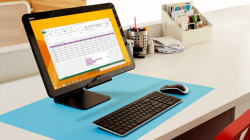 It’s been a year since the initial release of the Microsoft Windows 8 operating system, and it has yet to make a major impact in the business or consumer markets. Microsoft’s attempt was to create a hybrid of desktop, Windows 7, and mobile operating system, apparently in an attempt to make everyone happy. Thus far it has made few people happy. The reasons are many, but Windows 8 is a major move away from Windows’ strength – the desktop and laptop market.
It’s been a year since the initial release of the Microsoft Windows 8 operating system, and it has yet to make a major impact in the business or consumer markets. Microsoft’s attempt was to create a hybrid of desktop, Windows 7, and mobile operating system, apparently in an attempt to make everyone happy. Thus far it has made few people happy. The reasons are many, but Windows 8 is a major move away from Windows’ strength – the desktop and laptop market.
Full Screen Menu
The first major problem with the Windows upgrade is a full screen startup menu, a feature which has been significantly modified for the annual upgrade of Windows 8.1. Think about it – a full screen menu on a 27 inch display. Looks and functionality are two very different things, and while it may look like a good idea, it simply is not. It is reported PC maker Lenovo has a version that comes with its PC’s that immediately takes the user to the original start menu with one click.
Who Cares?
Apparently, Microsoft thought it must enter the mobile computing market because of the decline of PC sales and the ascending of tablets. But they are way behind the curve as Google’s Android operating system and Chrome notebook have established themselves as filling the need for consumers who want strictly mobile use and who care less about the power of a desktop or laptop computer. Apple has its core of diehard users, and Windows 8 is of zero interest to them. So who is the real market for Windows 8? That is a question Microsoft may still not be able to answer.
Market Core Blahs
Any company releasing a new upgrade of a product where the majority of its sales lie should make sure that group is willing to jump on board shortly after its initial release. Windows 8 has not been adopted by businesses yet, and is not likely to be adopted until some time during 2014, pending the new release due out in this calendar quarter. The conversion rate is likely to be slow depending on changes that are made and the general temperature of the economy. Most businesses are hanging on to their older versions of Windows because, well, they work and users are familiar with them.
The Real Question
The real question is why spend more money on another operating system that has yet to be widely accepted, is trying to do too much, and is trying to be something it is not? One major distinction between Microsoft and Apple over the years has been the target market focus – Apple on consumers and Microsoft on businesses. What has taken place is the shift from a business-oriented use of computers to a consumer driven computing mentality. Steve Jobs said that about the iPhone and iPad. They were designed to be consumer devices, not technology that would challenge the masses but make technology simple. When operating systems of all devices – smartphones, PCs, laptops, and tablets – are taken into consideration, Windows has fallen from the number one choice for buyers.
Conclusion
The suggestion box has been opened and the Windows 8 upgrade is near, set to present the changes critics have been asking for. But with such low sales numbers, how significant can the upgrade be to attract new buyers or have businesses willing to invest in the latest release? Computer users need a reason to spend money on an upgrade, developers a reason to create new software, businesses have to consider the return on investment of the upgrade. Without a practical reason for any of these groups, the question is not when everyone will use Windows 8 but if anyone except a minority will ever use it.
This article was contributed to dotTech by Vanessa Carrie. Vanessa is a consumer advocate who writes product reviews and stories about personal finance. Her recent work is on the Top 10 Colleges for a Cheap Online Degree.

 Email article
Email article



